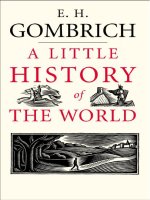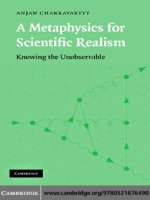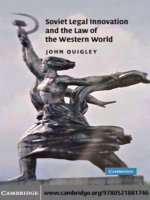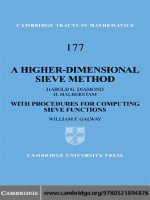0521441978 cambridge university press a monetary history of the ottoman empire mar 2000
Bạn đang xem bản rút gọn của tài liệu. Xem và tải ngay bản đầy đủ của tài liệu tại đây (2.38 MB, 302 trang )
A Monetary History of the Ottoman Empire
The Ottoman Empire stood at the crossroads of intercontinental trade at the dawn
of the era of capitalism. For the Ottomans coinage was a major symbol of
sovereignty and the leading means of exchange. This volume examines the monetary
history of that empire from its beginnings in the fourteenth century until the end of
the First World War. Through a detailed examination of the currencies and related
institutions of an empire which stretched from the Balkans through Anatolia, Syria,
Egypt, and the Gulf to the Maghrib, the book demonstrates the complexity of the
monetary arrangements and their evolution in response to both local developments
and global economic forces. Currency debasements, in¯ation and the ensuing
popular opposition are studied in a political economy framework. The volume also
affords valuable insights into social and political history and the evolution of
Ottoman institutions. This is an important book by one of the most distinguished
economic historians in the ®eld.
SË EVKET PAMUK is Professor of Economics and Economic History at BogÏazicËi
University. His publications include A History of the Middle East Economies in the
Twentieth Century (with Roger Owen, 1998), and The Ottoman Empire and European
Capitalism, 1820±1913 (1987).
This Page Intentionally Left Blank
Cambridge Studies in Islamic Civilization
Editorial board
dvid morgn (general editor)
virgini ksn mihel rett mihel ook peter jkson
trif khlidi roy motthedeh sim musllm
hse roinson
Titles in the series
stefn sperl, Mannerism in Arabic poetry: a Structural Analysis of Selected Texts,
3rd Century AH/9th Century AD±5th Century AH/11th Century AD 0 521 354854
pul eF wlker, Early Philosophical Shiism: the Ismaili Neoplatonism of AbuÅ
Ya«quÅb al-SijistaÅnõÅ 0 521 441293
oz shoshn, Popular Culture in Medieval Cairo 0 521 43209X
stephen frederi dle, Indian Merchants and Eurasian Trade, 1600±1750
0 521 454603
my singer, Palestinian Peasants and Ottoman Of®cials: Rural Administration
around Sixteenth-Century Jerusalem 0 521 452384 (hardback) 0 521 476798
(paperback)
mihel hmerlin, Knowledge and Social Practice in Medieval Damascus,
1190±1350 0 521 565069
trif khlidi, Arabic Historical Thought in the Classical Period 0 521 465540
(hardback) 0 521 58938X (paperback)
reuven mitiEpreiss, Mongols and Mamluks: The Mamluk-IÅlkhaÅnid War, 1260±
1281 0 521 462266
louise mrlow, Hierarchy and Egalitarianism in Islamic Thought 0 521 564301
jne hthwy, The Politics of Households in Ottoman Egypt: the Rise of the
QazdagÆlis 0 521 571103
thoms tF llsen, Commodity and Exchange in the Mongol Empire: a Cultural
History of Islamic Textiles 0 521 583012
din rizk khoury, State and Provincial Society in the Ottoman Empire: Mosul,
1540±1834 0 521 590604
thoms philipp nd ulrih hrmnn (eds.), The Mamluks in Egyptian
Politics and Society 0 521 591155
peter jkson, The Delhi Sultanate: a Political and Military History 0 521 404770
kte fleet, European and Islamic Trade in the Early Ottoman State: the Merchants
of Genoa and Turkey 0 521 64221 3
tye elEhiri, Reinterpreting Islamic Historiography: HaÅruÅn al-RashõÅd and the
Narrative of the «AbbaÅsid Caliphate 0 521 65023 2
edhem eldemD dniel goffmn nd rue msters , The Ottoman City
between East and West: Aleppo, Izmir, and Istanbul 0 521 64304X
This Page Intentionally Left Blank
A Monetary History
of the
Ottoman Empire
SË EVKET PAMUK
BogÆazicËi University, Istanbul
PUBLISHED BY CAMBRIDGE UNIVERSITY PRESS (VIRTUAL PUBLISHING)
FOR AND ON BEHALF OF THE PRESS SYNDICATE OF THE UNIVERSITY OF CAMBRIDGE
The Pitt Building, Trumpington Street, Cambridge CB2 IRP
40 West 20th Street, New York, NY 10011-4211, USA
477 Williamstown Road, Port Melbourne, VIC 3207, Australia
© Cambridge University Press 2000
This edition © Cambridge University Press (Virtual Publishing) 2003
First published in printed format 2000
A catalogue record for the original printed book is available
from the British Library and from the Library of Congress
Original ISBN 0 521 44197 8 hardback
ISBN 0 511 00850 3 virtual (netLibrary Edition)
To YesËim
This Page Intentionally Left Blank
Contents
List of maps, graphs, and tables
List of illustrations
Preface
Acknowledgments
Note on transliteration
page xii
xiv
xvii
xviv
xxvi
1
Introduction
Trade, money, and states in the Mediterranean basin
Ottoman economic policies
Money, economy, and the Ottoman state
A periodization
1
1
9
16
19
2
Trade and money at the origins
Gold and silver; East and West
Byzantine Empire and the Balkans
Anatolia
Early Ottoman coinage
Mints and their administration
Silver mines
Copper coinage
21
21
26
28
30
34
36
38
3
Interventionism and debasements as policy
Centralization and interventionism
The silver famines
The debasements of Mehmed II
Motives and explanations
Towards a political economy of Ottoman debasements
40
41
43
47
50
55
4
The emerging monetary system
The gold sultani: an ``international'' coin
Foreign coins
Gold±silver±copper
Bimetallism or silver monometallism?
Increasing use of money
59
59
62
66
70
74
ix
x
Contents
5
Credit and ®nance
Credit
Business partnerships
State ®nances and ®nancing the state
77
78
83
84
6
Money and empire
Monetary zones within the Empire
The Balkans
Egypt
The shahi zone
The Crimean akcËe
The Maghrib
Algeria
Tunis
Tripoli
88
88
89
95
101
105
107
108
109
111
7
The Price Revolution in the Near East revisited
Competing explanations
New evidence and a review of the old
Why did prices rise in the Near East?
Long-term consequences of the Price Revolution
112
113
118
125
127
8
Debasement and disintegration
The debasement of 1585±86: a turning point?
Fiscal crises and monetary instability
Disappearance of the akcËe
131
131
138
142
9
In the absence of domestic currency
Debased coinage in Ottoman markets
Belated government intervention
The return of copper coinage
149
151
153
155
10
The new Ottoman kurusË
The Ottoman kurusË
Economic expansion and ®scal stability
Fiscal troubles and depreciaton of the kurusË
159
159
161
170
11
Linkages with the periphery
The para in Egypt
The riyal of Tunis
Algeria
Tripoli
Crimea
Convergence of currencies
172
172
178
182
184
185
186
Contents
xi
12 The Great Debasement
Attempts at ®nancial centralization
Evolution of internal borrowing
The Great Debasement (1808±34)
Financing the state: The Galata bankers
188
188
190
193
200
13 From bimetallism to the ``limping gold standard''
Integration to the world economy
Bimetallism, new coinage, and paper money
Banks for lending to the state
External borrowing
The limping gold standard
Commercial banking
The Financing of World War I
205
205
206
211
213
216
221
222
14 Conclusions
225
Appendix I
Excerpts from Ottoman laws on taxation, money,
mints, and mines
Appendix II Price indices for Istanbul, 1469±1914
Appendix III A note on basic economic and monetary magnitudes
231
235
241
Bibliography
Index
243
270
Maps, graphs, and tables
Map
Map I
Ottoman mints producing silver and gold coinage late
in the sixteenth century, during the reigns of Selim II,
1566±74 and Murad III, 1574±1595
page 91
Graphs
Graph 3.1
Graph 7.1
Graph 7.2
Graph 11.1
Graph 12.1
The pure silver content and the exchange rate of the akcËe
Prices in Istanbul, 1469±1700; in akcËes
Prices in Istanbul, 1490±1700; in grams of silver
The silver content of Ottoman currencies, 1700±1850
The debasement of the kurusË and prices in Istanbul,
1780±1850
Graph A-1 Prices in Istanbul in akcËes, 1469±1914
Graph A-2 Silver content of the akcËe, 1326±1870
Graph A-3 Prices in Istanbul in grams of silver, 1469±1870
49
121
123
181
194
236
238
239
Tables
Table 3.1
Table 4.1
Table 4.2
Table 4.3
Table 6.1
Table 6.2
Table 8.1
Table 8.2
Table 8.3
Table 9.1
xii
The Ottoman akcËe and its exchange rate, 1326±1477
The silver akcËe and the gold sultani, 1477±1582
The exchange rates of other coins expressed in akcËes,
1477±1582
Coinage found in the inheritance inventories (tereke) of
Bursa, 1462±1513
The para or medin of Egypt, 1524±1688
Exchange rates for Ottoman silver currencies, 1570±1600
A compilation of the available budgets of the Ottoman
central government, 1523±1688
The silver akcËe and the gold sultani, 1584±1689
The exchange rates of European coins expressed in akcËes,
1584±1731
Net revenues of the state from copper coinage, 1688±91
46
63
64
65
94
97
133
136
144
157
Maps, graphs and tables
Table 10.1 The silver kurusË and its exchange rate, 1690±1808
Table 10.2 The exchange rates of other coins and currency expressed
in kurusË, 1720±1810
Table 11.1 The silver content and the exchange rate of the para of
Egypt, 1690±1798
Table 11.2 The silver content of the riyal of Tunis, 1725±1881
Table 12.1 The silver kurusË and its exchange rate, 1800±1914
Table 13.1 The exchange rates of other currencies expressed in
Ottoman gold liras, 1850±1914
xiii
163
168
175
180
191
209
Illustrations
Money in the Ottoman Empire
(Following the appendices)
Fourteenth and ®fteenth centuries
1
2
3
4
5
6
7
8
9
AkcËes (1±3)
Orhan I, 727 H (1326±27), Bursa
Murad II, 834 H (1431), Edirne
È skuÈp (Skopje)
Mehmed II, 880 H (1475), U
10-akcËe piece
Mehmed II, 875 H (1475), Novo Brdo
Copper mangõrs (5±6)
Murad II (1421±44, 1445±51), Edirne
Mehmed II (1444, 1451±81)
Gold coins (7±9)
Sultani
Mehmed II, 883 H (1478±79), Kostantaniye
Venetian ducat, not dated
Florin of Florence
Sixteenth and seventeenth centuries
10
11
12
Para/medin (10±12)
SuÈleyman I, 927 H (1521), Damascus
Selim II (1566±74), Cairo
Mehmed IV (1648±87), Aleppo
13
AkcËe in Yemen
Murad IV (1623±40), Sana
14
Copper mangõr
Selim I, 924 H (1518), Damascus
xiv
Illustrations
Shahis (15±16)
15 SuÈleyman I (1520±66), Hille (Iraq)
16 Ibrahim (1640±48), Bagdad
17 Ottoman lari, Basra
18 Silver coin in Tripoli
Mehmed IV, 1083 H (1671)
19 Nasri
Ahmed I (1603±17), Tunis
20 AkcËe in Algiers
Selim I (1512±20)
Gold sultanis (21±22)
21 SuÈleyman I (1520±66), Cairo
22 SuÈleyman I (1520±66), Algiers
23 Dutch lion thaler (esedi gurusË)
24 Spanish eight-real piece (riyal gurusË)
25 Copper mangõr
SuÈleyman II (1687±91), Kostantaniye
Eighteenth century
26 Early zolota (3/4 of one kurusË)
SuÈleyman II (1687±91); minted in 1690 or 1691;
Kostantaniye
KurusËes (27±29)
27 Ahmed III (1703±30), Kostantaniye
28 Mustafa III (1757±74), Islambol
29 Selim III (1789±1803), Tripoli
30 Para
Osman III (1754±57), Kostantaniye
31 Copper Coin in Tunis
Mustafa III (1757±74)
32 Quarter budju
Selim III, 1214 H (1799±1800), Algiers
33 KurusË in Algiers
Mahmud II, 1237 H (1822)
Gold Coins (34±36)
34 Zer-i Istanbul
Ahmed III (1703±30), Islambol
xv
xvi
35
36
Illustrations
Zer-i mahbub
Mahmud I (1730±54), Cairo
Sultani
Osman III, 1170 H (1756±57), Algiers
37 and 38
Bills of Exchange
Nineteenth century
39
40
41
42
KurusË in the Early Nineteenth Century (39±40)
Mahmud II, 22nd regnal year, 1828±29, Kostantaniye
Mahmud II (1808±39), Bagdad
Post-reform coinage (41±42)
20 kurusËes
Abdulmecid, 11th regnal year, 1850, Kostantaniye
Gold lira
Abdulmecid (1839±61), Kostantaniye
43
100-KurusË kaime from the 1840s
44
Five-lira banknote of the Imperial Ottoman Bank issued in
1299 H (1882)
45
Five-lira kaime issued during World War I
These photographs have been obtained from the following sources:
Yapõ ve Kredi Bank Collection, Istanbul
American Numismatics Society Collection, New York City
Ali Akyõldõz, Osmanlõ Finans Sisteminde KagÏõt Para
Edhem Eldem's private collection
Archives of the Chamber of Commerce of Marseilles
Preface
This book is about money and empire and their place in the world economy
at the dawn of the era of capitalism. In its approach and focus, I have been
inspired by the insistence of a number of ®ne historians in recent decades,
most notably Fernand Braudel, my former teacher Carlo Cipolla,
V. Magalhaes-Godinho, Peter Spufford, and Pierre Vilar, that monetary
history needs to be painted on a large canvas. The strong, two-way
interaction between long-distance trade, specie ¯ows, and money makes the
adoption of a global perspective essential for understanding both the
Middle Ages and the Early Modern period. This is especially the case for
the monetary history of a large empire located at the crossroads of
intercontinental trade, always vulnerable to the vicissitudes of commerce,
payments, and monetary ¯ows. Monetary history thus offers us the
opportunity to transcend the compartmentalized approach of so many
historians and emphasize the linkages between the history of the Eastern
Mediterranean, or the Near East for the lack of a better term, and those of
Europe and South Asia over a period of six centuries.
One important problem in monetary history concerns prices, in¯ation,
and their impact on the Early Modern world. Ever since Earl J. Hamilton
reformulated the monetarist argument with evidence gathered from Spanish
archives more than half a century ago, historians have been debating the
causal linkage between the arrival of large amounts of gold and silver from
the Americas and the rise in prices in the Old World during the sixteenth
and early seventeenth centuries. Most prominent amongst the defenders of
this hypothesis in recent decades have been economic historians of monetarist persuasion and the adherents of the Annales School. More than two
È mer LuÈt® Barkan provided the most notable attempt to insert
decades ago O
the Ottoman case into the debate when he linked the Ottoman price
increases until the 1580s to trade and specie in¯ows from Europe using a
theoretical framework very similar to that of the Annales School. New
evidence recently compiled by Michel Morineau has shown, however, that
Hamilton's data were incomplete and that the volume of specie ¯ows into
Europe continued to increase during the seventeenth century even after
xvii
xviii
Preface
prices had begun to decline. His ®ndings now cast serious doubt on the
validity of the causal linkage between bullion in¯ows and in¯ation. A return
now to the earlier debates in view of these recent ®ndings might well provide
new insights into the linkages between the western and eastern ends of the
Mediterranean during the Early Modern era.
Unlike the limited number of earlier studies on Ottoman monetary
history, therefore, the present volume will adopt an empire-wide perspective
and focus on the whole of the Ottoman monetary system as much as on the
individual parts and the linkages between them. To the extent made possible
by the availability of sources, it will cover all regions of the Empire from the
Balkans and Crimea through Syria, Egypt, and the Gulf to the Maghrib.
Needless to say, the political, administrative, and economic linkages
between the center and these regions varied enormously over time. Moreover, the latter were drawn into very divergent patterns of trade and
payments ¯ows from Western Europe to the Indian Ocean. The volume will
thus emphasize the complexity and heterogeneity of these monetary
arrangements and their evolution in response to both local developments
and global economic forces. Such an empire-wide, ``big picture'' perspective
on monetary history will offer, I hope, important insights into other
questions, most notably into the history and evolution of Ottoman institutions and the very concept of empire, the nature of this entity and how the
Ottomans themselves viewed it.
A better understanding of monetary history should also provide new
insights into the economic and social history of these regions. When it came
to the availability and use of money, many historians have long believed
that credit was poorly developed and the markets in the Ottoman Empire
were permanently starved for specie and coinage. For example, Fernand
Braudel whose information about the Ottoman economy has not always
been accurate, observes in his popular, three-volume work on the rise of
capitalism:
Overall, commercial life in Turkey still had some archaic features . . . The reason
was that money, the sinews of western trade, usually made only ¯eeting appearances
in the Turkish Empire. Part of it found its way to the ever-open jaws of the sultan's
treasury, some of it was used to oil the wheels of top-level trade, and the rest drained
away in massive quantities to the Indian Ocean. The west was correspondingly free
to use its monetary superiority on the Levant market . . .1
There is no doubt that the Ottoman markets experienced periodic
shortages of specie. There were also periods such as the second half of the
seventeenth century when these shortages assumed a long-term character.
In fact, the passage above alludes to developments during this period. It
would not be appropriate, however, to characterize these shortages as a
1
Fernand Braudel, Civilization and Capitalism, Fifteenth to Eighteenth Century, vol. III: The
Perspective of the World (New York, NY: Harper and Row Publishers, 1982), 473.
Preface
xix
permanent feature of Ottoman economic life from the ®fteenth through the
eighteenth centuries. In fact, there is overwhelming evidence from a broad
range of archival and other sources that while the degree of monetization
varied considerably over time and space, use of money in Ottoman lands
was not limited to the urban population. With the increased availability of
specie and the growth of economic linkages between the urban and rural
areas especially in the sixteenth century, large segments of the rural
population came to use coinage, through their participation in markets and
because of state taxation of a wide range of economic activities. In addition,
small-scale but intensive networks of credit relations developed in and
around the urban centers. Peasants and nomads as well as artisans and
merchants took part in these monetary transactions. Similarly, the eighteenth century witnessed the establishment of a new Ottoman currency,
increasing availability of coinage and credit and growing linkages between
Istanbul and the Ottoman currencies in different parts of the Empire.
Monetary history also raises important questions about the nature of
state economic policies. The existing historiography has long emphasized
that the Ottoman government intervened regularly in the economy to
ensure the orderly provisioning of the urban economy, of the palace and the
army, and more generally, to maintain the traditional balances between the
peasant producers, guilds, and urban consumers. Within this conceptual
framework, it has been argued that the permanent application and enforcement of price ceilings (narh) in urban areas was a typical example of
Ottoman interventionism and rigidity in defense of a traditional order.
I have serious reservations about the sustainability of this picture. For
one thing, there is a good deal of evidence that the Ottomans became
increasingly more conscious, after the ®fteenth century, about the limitations of interventionism in economic affairs. They learned that price ceilings
which diverged substantially from the underlying market realities could not
be enforced for long periods of time. For this reason, Ottoman interventionism became increasingly selective. It was used primarily for the provisioning of the capital city and the army and for selected commodities.
Perhaps more importantly, the narh came to be considered not as permanent
policy but as an instrument reserved for extraordinary conditions such as
wars, exceptional dif®culties in the provisioning of the capital city, or
periods of monetary instability.
Because of the availability of only a small number of texts dealing with
monetary problems, our knowledge about Ottoman monetary thought is
rather limited. Nonetheless, it is still possible to trace its evolution by
examining government practices. The latter suggest that Ottoman bureaucrats soon learned, if they did not already know, that state interventionism
in monetary affairs was even more dif®cult than interventionism in trade
and the urban economy since specie, coinage, and payments ¯ows could
evade of®cial restrictions with much more ease than ¯ows of commodities.
xx
Preface
For this reason, they were, on the whole, ¯exible and pragmatic in their
approach to money and monetary affairs. A reassessment of these monetary
practices now should force us to reconsider our assumptions about
Ottoman economic practices and the ``Ottoman economic mind.''
Yet another insight offered by monetary history is that of the long-term
economic waves or conjunctures. There exists a strong, two-way interaction
between monetary and economic conditions. On the one hand, monetary
stability often helps pave the way for the expansion of trade and production.
Similarly, monetary instability or shortages of specie often have adverse
effects on credit, production, and trade. Conversely, economic prosperity or
expansion of economic activity often enables the state to raise additional
®scal revenue which contributes to monetary stability. There exists, therefore, a good deal of correlation in the long term between the monetary and
economic conditions. Study of the long-term monetary conditions and
conjunctures in Ottoman history may reveal, therefore, new evidence
regarding its long-term economic cycles and conjunctures.
Most economic historians agree, for example, that until the 1580s the
sixteenth century was a period of demographic and economic expansion, at
least in the core regions of the Empire. Evidence from monetary history is
consistent with this picture. The verdict for the seventeenth century, on the
other hand, is still mixed. Until recently, Ottoman historiography had
depicted an empire in permanent decline after the sixteenth century. This
paradigm is now being replaced by one that places greater emphasis on the
state's ability to reorganize itself as a way of adapting to changing
circumstances. This ¯exibility goes a long way toward explaining the
longevity of the Empire. As a corollary to this paradigmatic shift, economic
historians have been questioning whether the seventeenth and eighteenth
centuries were simply a period of crisis and stagnation. A number of people
have already emphasized the expansion of trade and the rise in production
during the eighteenth century. There is a good deal that monetary history
can offer this debate. The ®ndings of this volume suggest that while the
seventeenth century was a period of monetary instability and even disintegration, the old thesis of continuous decline can not be sustained. The
eighteenth century until the 1780s was in fact a period of recovery for the
Ottoman monetary system as a new currency was established and linkages
between the center and the periphery of the Empire were strengthened.
Obviously, these long-term trends have important economic and political
implications.
The ®ndings of this volume and my ongoing research on prices also
indicate that the period of most rapid debasement and in¯ation in Ottoman
history was not the late sixteenth and the early seventeenth centuries, the
era of the so-called Price Revolution, as economic historians had come to
believe, but the early decades of the nineteenth century before Tanzimat, a
period of wars, internal rebellions, and reform. While the state bene®ted
Preface
xxi
from debasements, the latter also created strong political opposition. A
political economy perspective will be particularly fruitful in the analysis of
Ottoman debasements. Establishing in more detail the causes, magnitudes,
and consequences of this rapid wave of price increases should thus shed
considerable light not only on the economic and social history but also on
the politics of that period.
Despite the considerable growth of research in Ottoman economic and
social history in recent decades, monetary history has remained one of the
least studied areas in the historiography of the Ottoman Empire and more
generally of the Middle East. There does not exist a comprehensive study
dealing with the basic features and the evolution of the monetary arrangements prevailing in different parts of the Empire, let alone the logic of the
overall system if one existed. The available works by economic historians
are rather dated and provide only partial coverage. The numismatics
literature, on the other hand, while quite useful in illuminating many
problem areas, remains limited in scope. Researchers in monetary history
also face the dangers and challenges of a large body of literature going back
to the chroniclers and court historians who have offered and then repeated
over the centuries bits and pieces on money and state ®nances some of
which is still useful but a good deal of which is incorrect and often
misleading.2 To sift out the good from the bad in this large body of material
requires, at the very least, an independent construction of the monetary
standards so that these narratives and assertions can be checked against
more reliable forms of evidence.
It became clear at an early stage of the project that a long-term study of
this kind would not be possible without detailed series on Ottoman
monetary units. In view of the limited nature of the archival evidence from
the mints and other sources, I relied extensively for this purpose on the
often incomplete but rewarding evidence from the numismatics literature on
Ottoman coinage. Using this large body of published materials along with
archival materials, I was able to construct, for the ®rst time, complete time
series for the monetary standards (weight, ®neness, and specie content) of
the Ottoman currencies, not only for the silver akcËe and kurusË and the gold
sultani of the core regions but also for the para, shahi, nasri and riyal issued
in the provinces. In this framework, a decline in the specie content of
coinage and/or other types of numismatic evidence for the deterioration of
their quality are taken as indications for the deterioration of state ®nances
and/or growing shortages of specie in the economy at large. These series
were then combined with and checked against the available evidence
obtained from a wide range of sources, archival and otherwise, on the
2
For example, M. Belen ``Belin,'' TuÈrkiye IÇktisadi Tarihi Hakkõnda Tetkikler, trans. M. Ziya
(Istanbul: Devlet Matbassõ, 1931); Ekrem KolerkõlõcË, Osmanlõ ImparatorlugÏunda Para,
(Ankara: DogÏusË Ltd. SËirketi Matbaasõ, 1958).
xxii
Preface
exchange rates of these units against the leading European currencies. A
large part of the analysis in this volume begins with the evidence and
insights offered by these time series presented in detailed tables throughout
the text. Nonetheless, those looking for a simple overview of Ottoman
monetary history in terms of the well-known identity M 6 V = P 6 Q will
surely be disappointed because, as discussed in appendix three, even if crude
approximations for the price level and the GNP can be attempted, we have
virtually no information about the Ottoman money supply except for two
points in time, 1460s and 1914.
Economic and social historians of the Middle East in the late Medieval
and Early Modern eras are still unable to make sense of the most basic of
monetary magnitudes involving prices, wages, and wealth even though
intertemporal comparisons of these magnitudes are the most basic prerequisites for studying the long dureÂe. With the construction of the time series for
the standards of different Ottoman currencies, it will now be possible to
study long-term trends in prices across the region and compare the
Ottoman case with others in the Old World.
In recent years I have been working on another related project on the
history of prices and wages in Istanbul and, to a more limited extent, other
Ottoman cities from the middle of the ®fteenth century until 1918. This
project has utilized a large volume of account books prepared not only for
state institutions such as the palace kitchen, but also for pious foundations
(vakõf ) and private individuals, annual lists of of®cial price ceilings issued
by the local authorities (narh) and other price and wage evidence available
from the Ottoman archives. Some preliminary results from the price series
have been incorporated into the present volume, most notably in chapters 7
and 12 and especially appendix two. Amongst other things, they show that
a) debasements were the most important cause of Ottoman price in¯ation
and b) prices in Istanbul expressed in grams of silver moved together with
prices around the Mediterranean in the medium and long term. The latter
result con®rms once again that due to the strength of the maritime trade,
the economy of the capital city remained well linked to economies thousands of miles away. Preliminary results also show that long-term price
trends in other cities across the Empire, especially in the coastal regions,
were not very different. The present volume, together with a forthcoming
work on the history of prices, wages, and perhaps wealth should thus make
it possible to compare the long-term evolution of the Ottoman economy
with many others for which such series have already been constructed.
A brief note may be appropriate here about the photographs of coins and
paper currency presented in the volume. My purpose in these selections has
been to offer examples of the most common, most frequently used pieces.
An attempt was also made to re¯ect the geographic range of mint activity.
In these preferences I was driven by my concerns as an economic historian.
I know that my numismatist friends would have preferred to see some rare
Preface
xxiii
specimens in the following pages. While I have bene®ted enormously from
the work of numismatists in recent years, and can only hope to make a
partial payment in return with the present volume, I also came to realize
their concerns and emphases are often very different from those of economic
historians. In the last analysis, I feel that our respective preferences for these
plates is a very telling example of our differences as well as common
interests.
Acknowledgments
Over the years, I have accumulated debts in very many ways to a large
number of people. It is now a pleasure to ®nally acknowledge them. It
would have been impossible to attempt this project if Halil SahilliogÆlu had
not already spent decades laying the groundwork for Ottoman monetary
history through the seventeenth century. I would also like to thank him for
a number of illuminating conversations in recent years. My interest in
Ottoman monetary history took a turn for the serious when I was invited by
Halil IÇnalcõk to contribute an essay to the Cambridge volume on the
economic and social history of the Ottoman Empire. I am grateful to him
for his continued encouragement and support over the years as that chapter
È lcËer contributed to
grew into the present volume. The late CuÈneyt O
Ottoman numismatics more than any other person in this century and I
have bene®ted much from his published work.
I have learned greatly from conversations and correspondence with a
number of people, especially in the gathering of sources, information, and
evidence about the changing monetary conditions in diverse regions of the
Empire. For this indispensable assistance, I would like to acknowledge IÇsa
AkbasË, Mehmet Arat, Nezihi Aykut, SËekuÈre Basman, Sadok Boubaker,
Yavuz Cezar, Christopher Clay, Michael Cook, Linda Darling, Abdelhamid
Fenina, Elena Frangakis-Syrett, Mehmet GencË, Nelly Hanna, ResËat
Kasaba, Hasan Kayalõ, Rudi Lindner, Mohammed El-Najdawi, John
McCusker, Rudi Matthee, Leslie Peirce, TuÈrkan Rado, Abdul-Karim
Rafeq, Linda Schilcher, Sarah Shields, Tal Shuval, Avram Udovitch,
Elizabeth Zachariadou, and Dror Ze'evi. A number of others read parts of
this manuscript at various stages of development or maturity. For their
helpful suggestions and comments I am indebted to Edhem Eldem, Linda
Darling, Dennis Flynn, Timur Kuran, Kenneth M. MacKenzie, Donald
Quataert, Faruk Tabak, and Zafer Toprak. In recent years, I have had the
good fortune to work with the able research assistants, GuÈven Bakõrezer,
È zbek, IsËõk O
È zel, Figen TasËkõn and Hamdi Tuncer. I
Cem Emrence, Nadir O
would also like to acknowledge my debt to the organizers and participants
of seminars and conferences at the following universities where I presented
xxiv
Acknowledgments
xxv
parts of this work: American University in Cairo, Ben Gurion, BogÆazicËi,
Columbia, Harvard, Michigan at Ann Arbor, Middle East Technical, Ohio
State, Princeton, Tel Aviv, Utah, Venice, and Washington at Seattle. The
responsibility for all the views and the errors in this volume belongs, of
course, solely to the author.
In recent years, I have worked at a number of ®ne libraries in pursuit of
detail on the monetary histories of a large geography. Amongst these I
would like to especially acknowledge the collection and staff of the Firestone Library at Princeton University. I am also indebted to the staff of the
Prime Ministry's Ottoman archives at Istanbul for their assistance over a
long period. My work on Ottoman monetary standards was made much
easier by access to the ®ne collection of Ottoman coinage at the American
Numismatic Society in New York. I am especially indebted to Michael
Bates, the Curator of Islamic Coins for his assistance during my work there.
I would like to thank both the American Numismatics Society and the Yapõ
ve Kredi Bankasõ Cultural Center at Istanbul as well as SËennur SËentuÈrk, the
Director, for their kind permission to publish some photographs of coins in
their collections. Ali Akyõldõz and Edhem Eldem also provided photographs, of paper bills and bills of exchange. I would also like to thank
Marigold Acland and Lesley Atkin at Cambridge University Press for their
patience, support, and expert assistance in every stage of the project.
Parts of chapters 8 and 9 had appeared as part of the article ``In the
Absence of Domestic Currency: Debased European Coinage in the Seventeenth-Century Ottoman Empire,'' published in The Journal of Economic
History in 1997. I would like to thank Cambridge University Press for
permission to use these materials here.
Finally, I am indebted to the Ataturk Institute, the Department of
Economics, and the Research Fund Project No. 97±HZ101 of BogÆazicËi
University as well as the Academy of Sciences of Turkey for their support of
this research project.









